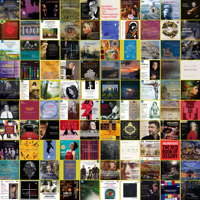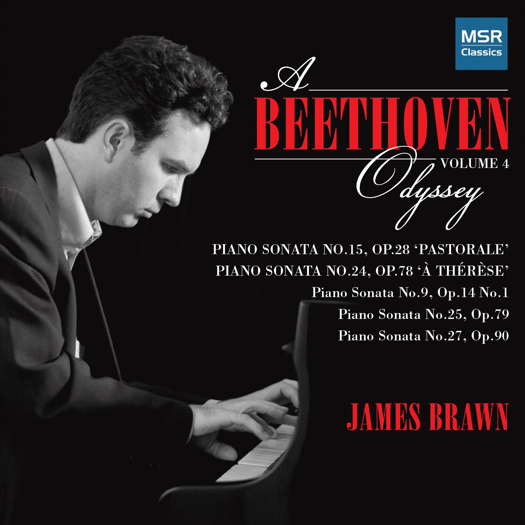- Slovak Republic
- Richard Gill
- Warner Classics
- Paul Reale
- Finn Mortensen
- comment
- Antonio Soler
- Belle Miriam Silverman

A Coloratura Contest
GIUSEPPE PENNISI witnesses a true triumph
with Donizetti's 'Anna Bolena' in Rome
with Donizetti's 'Anna Bolena' in Rome
After a lukewarm start with Rigoletto, the 2018-19 Teatro dell'Opera di Roma season had a real jump with the second new production: Gaetano Donizetti's Anna Bolena. The production, a joint venture with the Lithuanian National Opera and Ballet, had its premiere on 20 February 2019 to a sold-out house. It was a real triumph. I was in the audience.
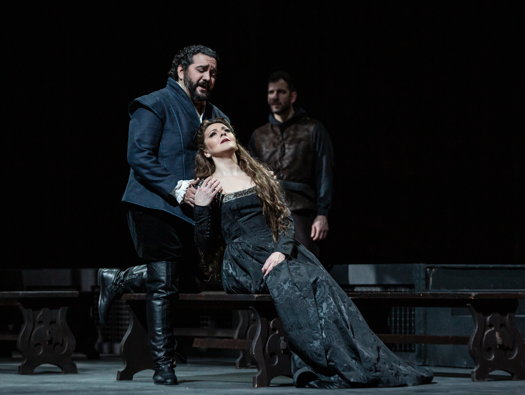
René Barbera as Lord Percy and Maria Agresta as Anna Bolena in Donizetti's Anna Bolena at Teatro dell'Opera di Roma. Photo © 2019 Yasuko Kageyama
Anna Bolena is the first of Donizetti's 'Tudor Queens Trilogy' composed during the period 1830-37, and was very successful during the first half of the nineteenth century. In addition to Anna Bolena, the trilogy includes two other lyric tragedies, Maria Stuarda and Roberto Devereux, whilst a fourth Donizetti opera dealing with the Tudor period - Elisabetta al Castello di Kenilworth - is a rarely revived semi-serious melodrama.
The 'Trilogy' as such was forgotten for several decades. In the 1970s it became, for almost ten years, a major hit of New York City Opera, where Beverly Sills was the interpreter of the three operas, often staged within three to five days. Anna Bolena had been revived at La Scala in 1957 in an extraordinary production starring Maria Callas as the protagonist. Since then, the work has been a favorite vehicle for bel canto specialists such as Joan Sutherland and Montserrat Caballé.
The title role is written for an 'amphibious' or 'falcon' soprano able to ascend to a very high register and then to descend to a very low one. It was conceived for Giuditta Pasta who premiered it in Milan in 1830; the tenor was the famous Giovanni Battista Rubini, at the time 'the king of high Cs'. The singing is impervious also because the lyric tragedy is long - four hours with a twenty minute intermission. The last aria by the protagonist has a duration of nearly twenty minutes. Often, the opera is cut drastically. In this new production in Rome, the opera is presented unabridged. I remember only another unabridged production: in 2007 at the Teatro Filarmonico in Verona with Mariella Devia in the title role. There is a live recording of Callas' La Scala performance; there are cuts of almost 45 minutes.
Casting Anna Bolena is very hard: it requires a second coloratura soprano (for the role of Giovanna Seymour), an agility tenor (Lord Percy), an agility bass (Henry VIII), a mezzo in a trouser role (Smeton) and an agility baritone (Lord Rochefort). The opera is mostly a coloratura context between the two sopranos in very difficult duets with rondo. There are various slants in interpreting the taxing title role: Maria Callas emphasized the tragic element and the descent to a low register, while Montserrat Caballé delivered a tender Bolena. Often, Giovanna Seymour is handled by a mezzo.
These difficulties indicate why Anna Bolena is the least performed opera of the 'Tudor Trilogy'. In Teatro dell'Opera's history there have only been three sets of performances, the last in 1979. Thus, this new production was much awaited; on 20 February, several music reviewers had come from the rest of Italy as well as from other European countries.
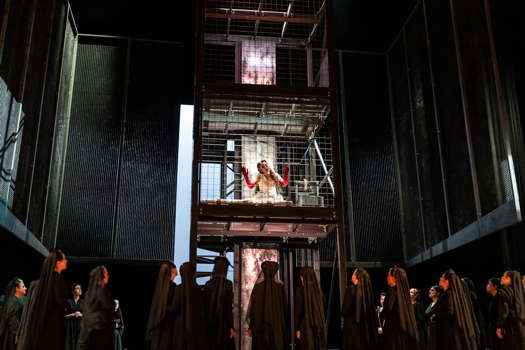
A scene from Donizetti's Anna Bolena at Teatro dell'Opera di Roma. Photo © 2019 Yasuko Kageyama
Their travel was well rewarded. Luigi Ferrigno's stage set is simple but functional: a single unit of platforms with walls. This helps the singers' projection. Ursula Patzak's costumes are mostly black and white, which helps to create a tragic atmosphere. Andrea De Rosa's stage direction moves the action quite well and at a good pace. The orchestra, conducted by Riccardo Frizza, provides the appropriate tints, with emphasis on the dark musical colors of the cellos. The chorus, led by Roberto Gabbiani, sustained the tragedy effectively.
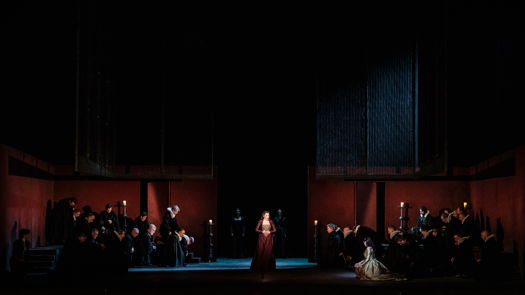
A scene from Donizetti's Anna Bolena at Teatro dell'Opera di Roma. Photo © 2019 Yasuko Kageyama
Anna Bolena consists primarily of singing. The two sopranos, Maria Agresta as Bolena and Carmela Remigio as Giovanna Seymour, were new to their roles and impressive in their coloratura duel. Agresta is almost a tragic 'falcon' soprano in the style of Maria Callas, while Remigio is a sensual and ambitious Giovanna.
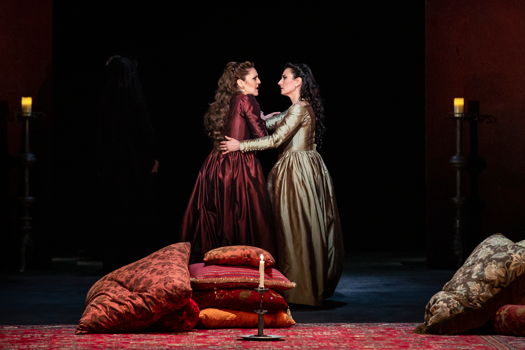
Maria Agresta as Anna Bolena and Carmela Remigio as Giovanna Seymour in Donizetti's Anna Bolena at Teatro dell'Opera di Roma. Photo © 2019 Yasuko Kageyama
René Barbera (Lord Percy) unveiled strong high Cs, Alex Esposito was a lusty King Henry VIII, Martina Belli an excellent Smeton and Andrii Ganchuk a very good Lord Rochefort.
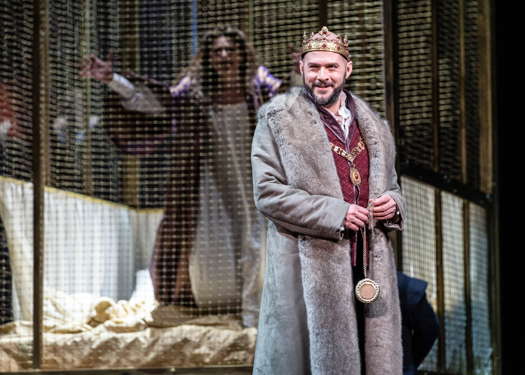
Alex Esposito as King Henry VIII in Donizetti's Anna Bolena at Teatro dell'Opera di Roma. Photo © 2019 Yasuko Kageyama
The performance started at 8pm. There were several bouts of open stage applause and, a few minutes after midnight, a true triumph.
Rome, Italy



